Efficient Mode Conversion from a Standard Single-Mode Fiber to a Subwavelength-Diameter Microfiber
Abstract
:1. Introduction
2. Concept and Numerical Simulations
3. Experimental Results and Discussion
4. Conclusions
Author Contributions
Funding
Data Availability Statement
Acknowledgments
Conflicts of Interest
Appendix A. Misalignment Tolerance Analysis
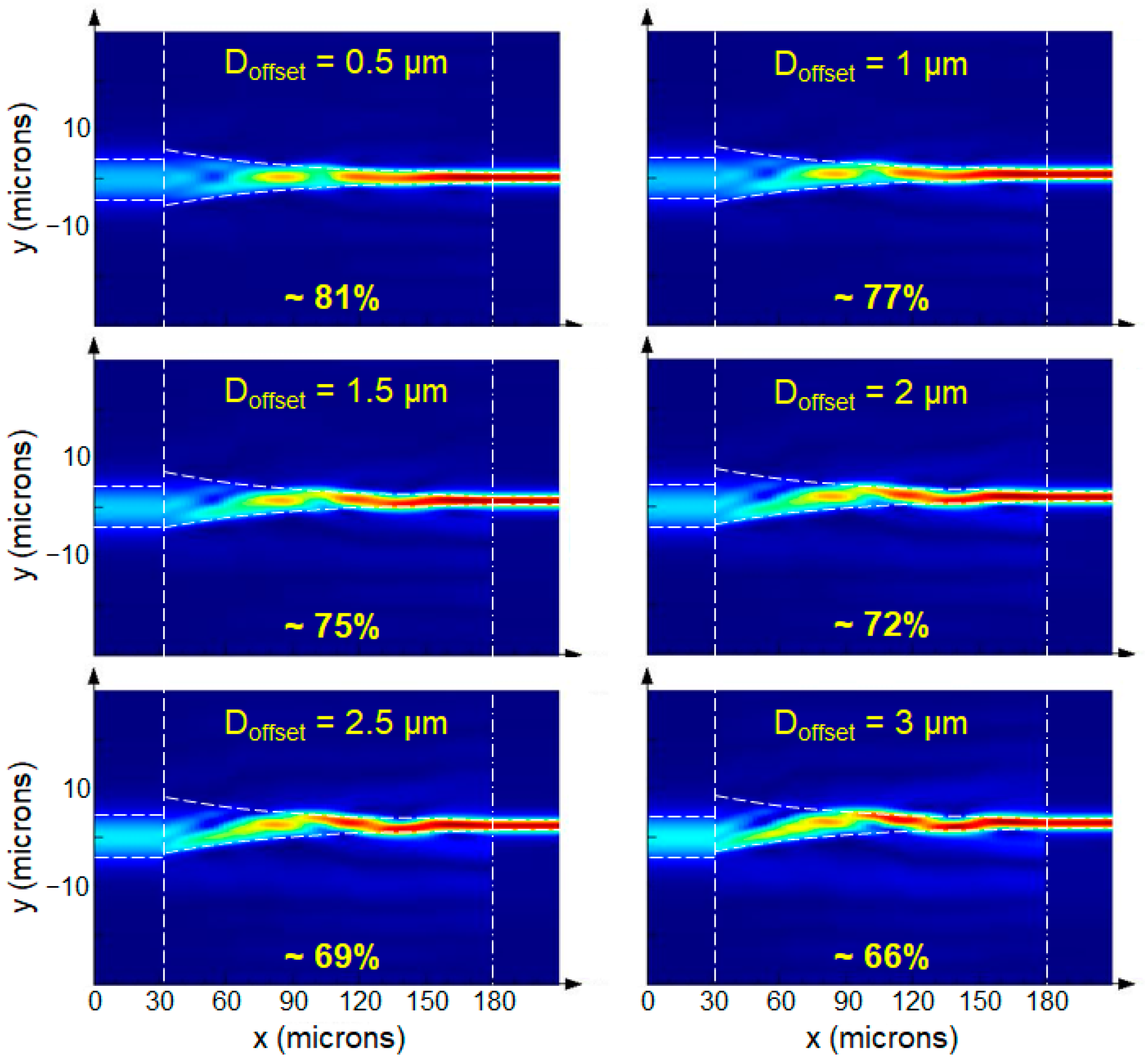
References
- Mitomi, O.; Kasaya, K.; Miyazawa, H. Design of a Single-Mode Tapered Waveguide for Low-Loss Chip-to-Fiber Coupling. IEEE J. Quantum Electron. 1994, 30, 1787–1793. [Google Scholar] [CrossRef]
- Moerman, I.; Van Daele, P.P.; Demeester, P.M. A Review on Fabrication Technologies for the Monolithic Integration of Tapers with III-V Semiconductor Devices. IEEE J. Sel. Top. Quantum Electron. 1997, 3, 1308–1320. [Google Scholar] [CrossRef]
- Shoji, T.; Tsuchizawa, T.; Watanabe, T.; Yamada, K.; Morita, H. Low Loss Mode Size Converter from 0.3 Μm Square Si Wire Waveguides to Singlemode Fibres. Electron. Lett. 2002, 38, 1669–1670. [Google Scholar] [CrossRef]
- Almeida, V.R.; Panepucci, R.R.; Lipson, M. Nanotaper for Compact Mode Conversion. Opt. Lett. 2003, 28, 1302–1304. [Google Scholar] [CrossRef] [PubMed]
- Galán, J.V.; Sanchis, P.; Sánchez, G.; Martí, J. Polarization Insensitive Low-Loss Coupling Technique between SOI Waveguides and High Mode Field Diameter Single-Mode Fibers. Opt. Express 2007, 15, 7058–7065. [Google Scholar] [CrossRef]
- Mu, X.; Wu, S.; Cheng, L.; Fu, H.Y. Edge Couplers in Silicon Photonic Integrated Circuits: A Review. Appl. Sci. 2020, 10, 1538. [Google Scholar] [CrossRef]
- Intaraprasonk, V.; Fan, S. Optical Pulling Force and Conveyor Belt Effect in Resonator–Waveguide System. Opt. Lett. 2013, 38, 3264–3267. [Google Scholar] [CrossRef]
- Rogers, E.T.F.; Savo, S.; Lindberg, J.; Roy, T.; Dennis, M.R.; Zheludev, N.I. Super-Oscillatory Optical Needle. Appl. Phys. Lett. 2013, 102, 31108. [Google Scholar] [CrossRef]
- Yang, L.; Zhou, Z.; Wu, H.; Dang, H.; Yang, Y.; Gao, J.; Guo, X.; Wang, P.; Tong, L. Generating a Sub-Nanometer-Confined Optical Field in a Nanoslit Waveguiding Mode. Adv. Photonics 2023, 5, 046003. [Google Scholar] [CrossRef]
- Yang, B.; Chen, G.; Ghafoor, A.; Zhang, Y.; Zhang, Y.; Zhang, Y.; Luo, Y.; Yang, J.; Sandoghdar, V.; Aizpurua, J.; et al. Sub-Nanometre Resolution in Single-Molecule Photoluminescence Imaging. Nat. Photonics 2020, 14, 693–699. [Google Scholar] [CrossRef]
- Salsi, M.; Koebele, C.; Sperti, D.; Tran, P.; Mardoyan, H.; Brindel, P.; Bigo, S.; Boutin, A.; Verluise, F.; Sillard, P.; et al. Mode-Division Multiplexing of 2 × 100 Gb/s Channels Using an LCOS-Based Spatial Modulator. J. Light. Technol. 2012, 30, 618–623. [Google Scholar] [CrossRef]
- Ryf, R.; Randel, S.; Gnauck, A.H.; Bolle, C.; Sierra, A.; Mumtaz, S.; Esmaeelpour, M.; Burrows, E.C.; Essiambre, R.-J.; Winzer, P.J.; et al. Mode-Division Multiplexing Over 96 Km of Few-Mode Fiber Using Coherent 6 × 6 MIMO Processing. J. Light. Technol. 2012, 30, 521–531. [Google Scholar] [CrossRef]
- Shaltout, A.M.; Shalaev, V.M.; Brongersma, M.L. Spatiotemporal Light Control with Active Metasurfaces. Science 2019, 364, eaat3100. [Google Scholar] [CrossRef] [PubMed]
- Chen, S.; Liu, W.; Li, Z.; Cheng, H.; Tian, J. Metasurface–Empowered Optical Multiplexing and Multifunction. Adv. Mater. 2020, 32, e1805912. [Google Scholar] [CrossRef]
- Ahmadivand, A.; Gerislioglu, B.; Ahuja, R.; Mishra, Y.K. Toroidal Metaphotonics and Metadevices. Laser Photon. Rev. 2020, 14, 1900326. [Google Scholar] [CrossRef]
- Hanzawa, N.; Saitoh, K.; Sakamoto, T.; Matsui, T.; Tomita, S.; Koshiba, M. Demonstration of Mode-Division Multiplexing Transmission over 10 Km Two-Mode Fiber with Mode Coupler. In Proceedings of the Optical Fiber Communication Conference/National Fiber Optic Engineers Conference, Los Angeles, CA, USA, 6–10 March 2011; OSA: Washington, DC, USA, 2011; p. OWA4. [Google Scholar]
- Marcuse, D. Mode Conversion in Optical Fibers with Monotonically Increasing Core Radius. J. Light. Technol. 1987, 5, 125–133. [Google Scholar] [CrossRef]
- Dai, D. Advanced Passive Silicon Photonic Devices With Asymmetric Waveguide Structures. Proc. IEEE 2018, 106, 2117–2143. [Google Scholar] [CrossRef]
- Lee, Y.-S.; Lim, K.-S.; Zaini, M.K.A.; Ahmad, H. LP11–LP01 Mode Conversion Based on an Angled-Facet Two-Mode Fiber. IEEE Photonics Technol. Lett. 2017, 29, 1007–1010. [Google Scholar] [CrossRef]
- Yao, N.; Zhou, J.; Gao, R.; Lin, J.; Wang, M.; Cheng, Y.; Fang, W.; Tong, L. Efficient Light Coupling between an Ultra-Low Loss Lithium Niobate Waveguide and an Adiabatically Tapered Single Mode Optical Fiber. Opt. Express 2020, 28, 12416–12423. [Google Scholar] [CrossRef]
- Khan, S.; Buckley, S.M.; Chiles, J.; Mirin, R.P.; Nam, S.W.; Shainline, J.M. Low-Loss, High-Bandwidth Fiber-to-Chip Coupling Using Capped Adiabatic Tapered Fibers. APL Photonics 2020, 5, 056101. [Google Scholar] [CrossRef]
- Tong, L.; Sumetsky, M. Subwavelength and Nanometer Diameter Optical Fibers, 1st ed.; Advanced Topics in Science and Technology in China; Springer: Berlin/Heidelberg, Germany, 2010; ISBN 978-3-642-03362-9. [Google Scholar]
- Nagai, R.; Aoki, T. Ultra-Low-Loss Tapered Optical Fibers with Minimal Lengths. Opt. Express 2014, 22, 28427–28436. [Google Scholar] [CrossRef] [PubMed]
- Yao, N.; Yao, Q.; Xie, X.-P.; Liu, Y.; Xu, P.; Fang, W.; Fang, W.; Zheng, M.-Y.; Zheng, M.-Y.; Fan, J.; et al. Optimizing Up-Conversion Single-Photon Detectors for Quantum Key Distribution. Opt. Express 2020, 28, 25123–25133. [Google Scholar] [CrossRef] [PubMed]
- Zhang, L.; Pan, J.; Zhang, Z.; Wu, H.; Yao, N.; Cai, D.; Xu, Y.; Zhang, J.; Sun, G.; Wang, L.; et al. Ultrasensitive Skin-like Wearable Optical Sensors Based on Glass Micro/Nanofibers. Opto-Electron. Adv. 2020, 3, 19002201–19002207. [Google Scholar] [CrossRef]
- Kim, S.; Yu, N.; Ma, X.; Zhu, Y.; Liu, Q.; Liu, M.; Yan, R. High External-Efficiency Nanofocusing for Lens-Free near-Field Optical Nanoscopy. Nat. Photonics 2019, 13, 636–643. [Google Scholar] [CrossRef]
- Gattass, R.R.; Svacha, G.T.; Tong, L.; Mazur, E. Supercontinuum Generation in Submicrometer Diameter Silica Fibers. Opt. Express 2006, 14, 9408–9414. [Google Scholar] [CrossRef]
- Zhao, X.; Zhao, N.; Shi, Y.; Xin, H.; Li, B. Optical Fiber Tweezers: A Versatile Tool for Optical Trapping and Manipulation. Micromachines 2020, 11, 114. [Google Scholar] [CrossRef]
- Lou, Y.; Wu, D.; Pang, Y. Optical Trapping and Manipulation Using Optical Fibers. Adv. Fiber Mater. 2019, 1, 83–100. [Google Scholar] [CrossRef]
- Farsari, M.; Chichkov, B.N. Two-Photon Fabrication. Nat. Photonics 2009, 3, 450–452. [Google Scholar] [CrossRef]
- Lindenmann, N.; Dottermusch, S.; Goedecke, M.L.; Hoose, T.; Billah, M.R.; Onanuga, T.P.; Hofmann, A.; Freude, W.; Koos, C. Connecting Silicon Photonic Circuits to Multicore Fibers by Photonic Wire Bonding. J. Light. Technol. 2015, 33, 755–760. [Google Scholar] [CrossRef]
- Nesic, A.; Blaicher, M.; Marin-Palomo, P.; Füllner, C.; Randel, S.; Freude, W.; Koos, C.; Nesic, A.; Blaicher, M.; Marin-Palomo, P.; et al. Ultra-Broadband Polarisation Beam Splitters and Rotators Based on 3D-Printed Waveguides. Light Adv. Manuf. 2023, 4, 251–262. [Google Scholar] [CrossRef]
- Vanmol, K.; Saurav, K.; Panapakkam, V.; Thienpont, H.; Vermeulen, N.; Watte, J.; Van Erps, J. Mode-Field Matching Down-Tapers on Single-Mode Optical Fibers for Edge Coupling Towards Generic Photonic Integrated Circuit Platforms. J. Light. Technol. 2020, 38, 4834–4842. [Google Scholar] [CrossRef]
- Birks, T.A.; Li, Y.W. The Shape of Fiber Tapers. J. Light. Technol. 1992, 10, 432–438. [Google Scholar] [CrossRef]
- Schmid, M.; Ludescher, D.; Giessen, H. Optical Properties of Photoresists for Femtosecond 3D Printing: Refractive Index, Extinction, Luminescence-Dose Dependence, Aging, Heat Treatment and Comparison between 1-Photon and 2-Photon Exposure. Opt. Mater. Express 2019, 9, 4564–4577. [Google Scholar] [CrossRef]
- Yu, H.; Wang, S.; Fu, J.; Qiu, M.; Li, Y.; Gu, F.; Tong, L. Modeling bending losses of optical nanofibers or nanowires. Appl. Opt. 2009, 48, 4365–4369. [Google Scholar] [CrossRef] [PubMed]
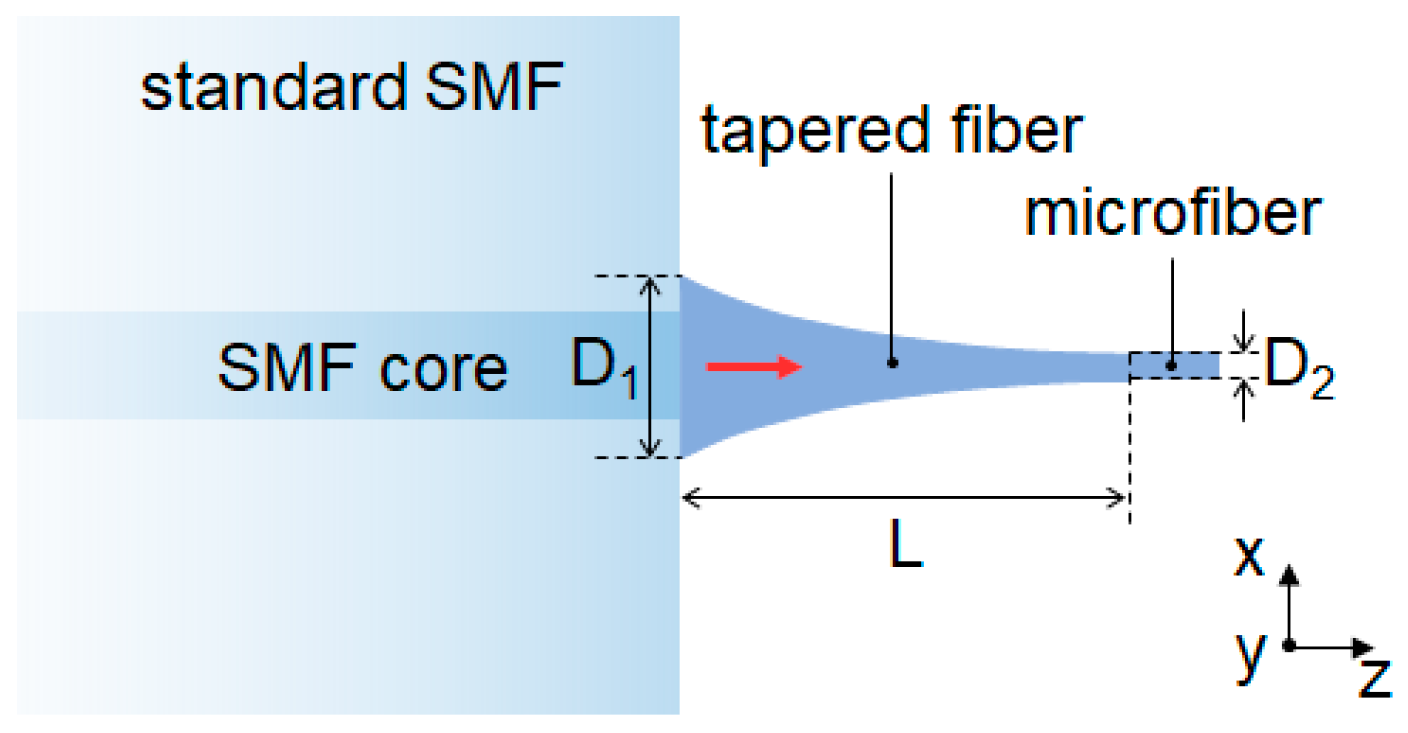
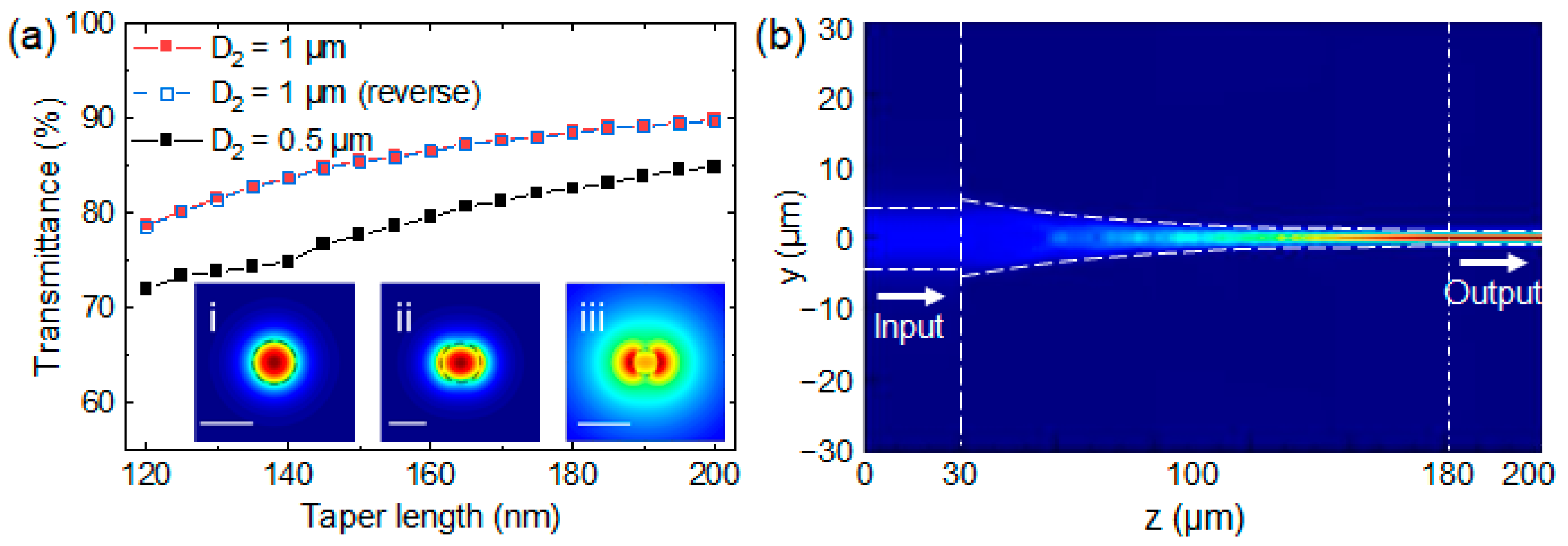
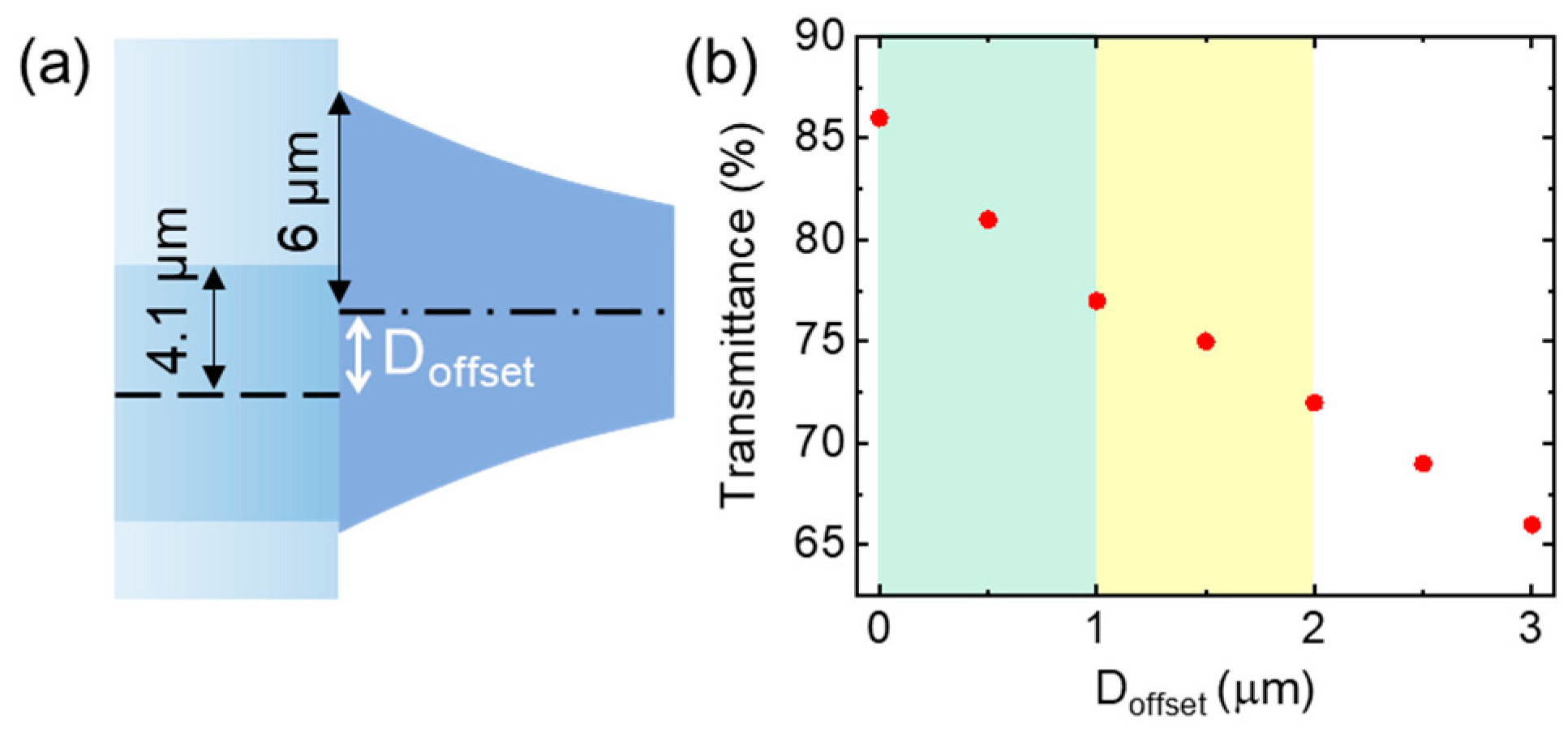
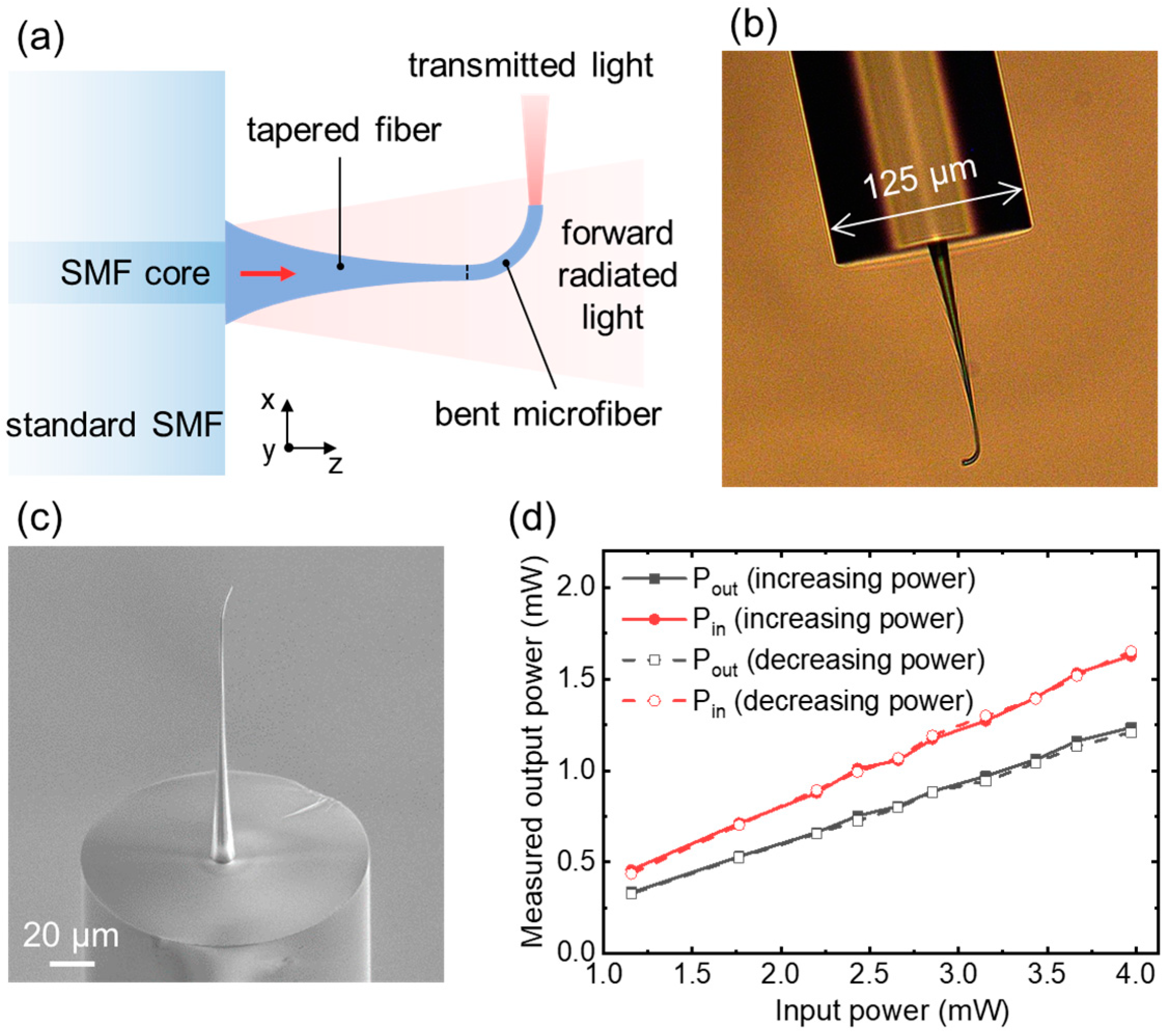
| Wavelength (nm) | Refractive Index of IP-L Resin | Transmittance (%) |
|---|---|---|
| 532 | 1.5232 | 69.83 |
| 633 | 1.5168 | 80.68 |
| 850 | 1.5105 | 78.61 |
| 1310 | 1.5062 | 86.55 |
| 1550 | 1.5053 | 85.62 |
Disclaimer/Publisher’s Note: The statements, opinions and data contained in all publications are solely those of the individual author(s) and contributor(s) and not of MDPI and/or the editor(s). MDPI and/or the editor(s) disclaim responsibility for any injury to people or property resulting from any ideas, methods, instructions or products referred to in the content. |
© 2023 by the authors. Licensee MDPI, Basel, Switzerland. This article is an open access article distributed under the terms and conditions of the Creative Commons Attribution (CC BY) license (https://creativecommons.org/licenses/by/4.0/).
Share and Cite
Wu, W.; Yu, H.; Wang, C.; Li, Z. Efficient Mode Conversion from a Standard Single-Mode Fiber to a Subwavelength-Diameter Microfiber. Nanomaterials 2023, 13, 3003. https://doi.org/10.3390/nano13233003
Wu W, Yu H, Wang C, Li Z. Efficient Mode Conversion from a Standard Single-Mode Fiber to a Subwavelength-Diameter Microfiber. Nanomaterials. 2023; 13(23):3003. https://doi.org/10.3390/nano13233003
Chicago/Turabian StyleWu, Wanling, Huakang Yu, Chunhua Wang, and Zhiyuan Li. 2023. "Efficient Mode Conversion from a Standard Single-Mode Fiber to a Subwavelength-Diameter Microfiber" Nanomaterials 13, no. 23: 3003. https://doi.org/10.3390/nano13233003





